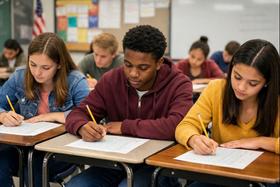School vouchers are a source of debate between public and private schools nationwide, but nowhere is the debate more acutely felt than in Indiana. Indiana is home to one of the largest voucher programs in the country, and many are waiting to see whether this program delivers on all of its promises. Vouchers are also a major point of contention in places like Wisconsin and Louisiana, where schools are fighting for students and parents are waiting to see if the benefits of school choice will come to fruition. Do vouchers improve the quality of education for all students? With inconclusive test results, the jury appears to be out still. However, that doesn’t change the intensity with which both sides fight for the type of education system they believe is best.
Competition Heats Up in Indiana
The Indiana voucher system is getting bigger this year, and public schools nationwide are feeling the heat. Fox News reports that the new voucher system first passed the Indiana legislature in 2011, and the hundreds of students who left public schools for private pastures last year could turn into thousands of students this year. Public schools are turning to advertising and door-to-door campaigning to keep kids in their neighborhood schools and funding in the public school system.
Currently, more than 8,000 students in Indiana have applied for the voucher program for the upcoming school year. There is room for as many as 15,000 students to take advantage of the ability to afford private school tuition through vouchers that equal per-student funding in public schools. Unlike other voucher programs that primarily target low-income families, the Indiana program offers vouchers to families of four with incomes of up to $64,000 per year. With an average annual income of $67,000 in the state, many school children qualify for the voucher program.
Advertising Dollars Spent
In response to the mass exodus of students from some Indiana schools, districts are launching ad campaigns to alert families to the changes being made in the public school system. Fox News cites public schools in the state that have purchased air time on radio stations and billboard space to lure families into staying or returning to the public school districts. One school district in the state spent $5,700 on two billboards to advertise their school programs. This amount is similar to what a school loses in funding every time a student leaves the public school system, which ranges from $5,300 to $8,400.
The Fort Wayne school district has launched a major ad campaign to the tune of $32,000. This campaign, titled “Their Stories. Your School. Get Back to School at FWCS,” features students from the district who have succeeded in the public school. The campaign is also directed at alerting parents and students to test scores and the graduation rate for the district, which currently stands at around 90 percent. Last year, Fort Wayne lost 392 students to the voucher program, which cost the district more than $2.6 million and forced district administrators to cut 10 music, art, and physical education teachers.
This video offers a look at vouchers from a research perspective.
Promoting Choice
The voucher program in Indiana isn’t just about choosing private schools. The Economist reports that the program also allows students to attend any public school of their choosing. Some believe that extending choice has had benefits for Indiana students. Public schools, forced to compete with many other options, have been forced to raise the bar on their education quality. Some have purchased technology for students that was never available in public schools. Tony Bennett, the superintendent of public instruction for Indiana, told the Economist that student performance indicators over the past two years have also shown promise.
Social justice, a concern for left-leaning supporters of vouchers, is another factor examined in the Indiana voucher program. Proponents of the program say that Indiana is also hitting the mark here since most students participating in the voucher system also qualify for free or reduced-price lunches in the state. Those earning a moderate income can also take advantage of the voucher system for a reduced value than those with greater financial need.
This video offers a look at vouchers from a teacher's point of view.
What the Tests Say
With the debate continuing, many believe it is time to turn to concrete evidence that voucher programs are improving educational quality. Due to a lack of a better benchmark, these educators turn to test scores to determine whether the programs are meeting their goals. However, the evidence supporting vouchers is shaky in this area. FortWayne.com published a report on test results from Indiana students last year, which showed private school scores took a slight dip while public school scores rose slightly. However, it has been pointed out that with a large influx of new students, drops in test scores should be expected. Educators will need to wait for more evidence before determining this state.
In Milwaukee, a five-year study showed some improvement in test scores for voucher schools over public schools. However, a recent state audit of those scores showed results to be inconclusive, according to a report in the Milwaukee Journal-Sentinel. The president of School Choice Milwaukee, Jim Bender, told the Journal-Sentinel that better uniformity is required in studies to ensure more accurate results.
While the jury may still be out from a test score standpoint, there are still strong feelings on both sides of the voucher issue. At this point, only time will tell whether school choice will provide the educational benefits promised.
Questions? Contact us on Facebook. @publicschoolreview











